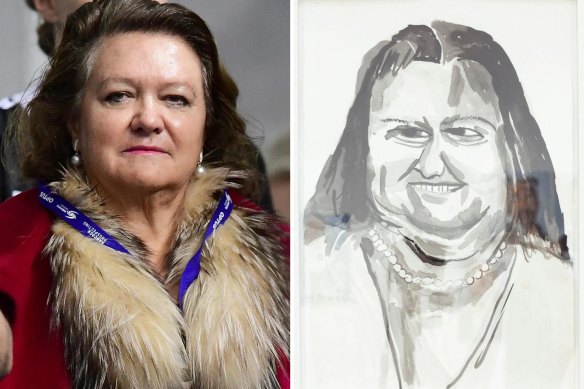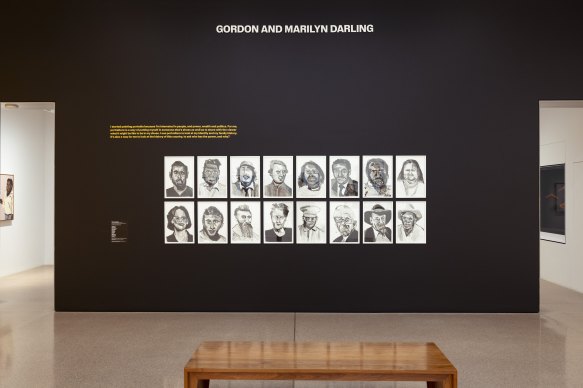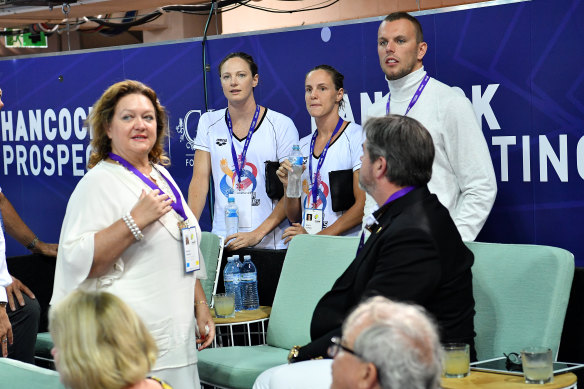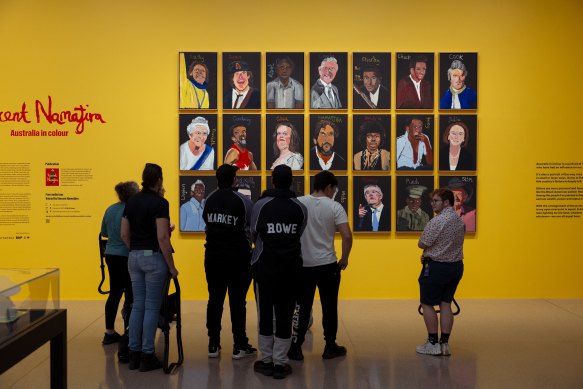- Exclusive
- Culture
- Art & design
- Indigenous art
This was published 1 year ago
The other portrait Gina Rinehart wants removed from the National Gallery
By Linda Morris and Eryk Bagshaw
A second portrait by Vincent Namatjira of Gina Rinehart has emerged which supporters of the mining magnate want pulled from the walls of the National Gallery of Australia.
The 2018 ink and pencil portrait of Australia’s richest person is shown separately inside the National Gallery as one of 16 artworks in the “Australia in black and white” display. The feature wall also includes drawings of AC/DC guitarist Angus Young, One Nation leader Pauline Hanson, media mogul Rupert Murdoch and Indigenous leader Eddie Mabo.

The second portrait of Gina Rinehart right, and the magnate herself, left.
The Sydney Morning Herald and The Age revealed on Thursday that Rinehart’s company Hancock Prospecting, which has paid more than $40 million in sponsorship to Australian swimmers, contacted Rio Olympic gold medallist Kyle Chalmers to lead a campaign against the portraits.
The first portrait of Rinehart, a watercolour, was revealed on Wednesday, but a second black-and-white portrait in the same exhibition has also become a target according to a letter to the gallery from Swimming Queensland chief Kevin Hasemann.
AFL legend Adam Goodes, who features in both sets of artworks in Namatjira’s major National Gallery survey, defended the artist on Friday.
“An artist’s view on the world is what it is,” Goodes said.
The two-time Brownlow Medal winner has been a frequent subject of Namatjira’s including his 2020 Archibald Prize-winning work.
“I have always loved the lens that Vincent has on our world,” he said.
Chalmers and Hasemann co-ordinated a group of 20 elite Australian athletes to call for the portraits to be removed. In a letter to National Gallery director Nick Mitzevich in April, Hasemann said: “Two portraits of our patron, Mrs Gina Rinehart AO, are of deep concern to us because they are offensive to Mrs Rinehart.”
Hasemann defended Swimming Queensland’s involvement in lobbying the gallery on Friday after questions were raised about the intersection of Rinehart’s use of money and power to influence culture and sport. Rinehart has a fortune estimated at $37.6 billion.

‘Australia in black and white’ by artist Vincent Namatjira on display in the National Gallery of Australia. Credit: Dominic Lorrimer
“It evolved into something I could never have imagined,” Hasemann told ABC Radio. “I’ve never been to a gallery. I’m a sports administrator. I don’t know why we have to defend ourselves. We privately did what the gallery encourages us to do: encourage debate.
“[We asked them] ‘pretty please will you mind taking it down?’ If they don’t, that’s their right.”
Fellow Archibald Prize winner Blak Douglas applauded the NGA’s decision to keep the portrait up and not buckle to pressure.
“It’s evident her narcissism has been challenged by one simple portrait,” he said. “One positive thing about exhibiting as a political artist is that by and large Australians have a great satirical appreciation. We are a nation of humorists and satirists and generally people will have a good chuckle about these things.”
Hailing from South Australia, Namatjira is the great-grandson of watercolourist Albert Namatjira and the first Indigenous artist to win the Archibald Prize. In 2020, the same year as he won the Archibald Prize, he received the Medal of the Order of Australia (OAM) in honour of his contribution to Indigenous visual arts.
His monograph, Vincent Namatjira, recently published by Thames & Hudson, features three portraits of Rinehart, including one of the portraits the billionaire mining mogul is demanding the NGA remove.

Gina Rinehart is seen talking to swimmers Cate Campbell (second from left), Bronte Campbell and Kyle Chalmers during the 2018 Australian swimming trials.Credit: AAP
In a chapter on power, Vincent discusses in depth his portraits of public figures, including Rinehart. Painting in a naive style, he aims to disarm the powerful in his portraits.
“I am really interested in people in positions of power; people who have incredible wealth and influence,” he states.
“When I see politicians, world leaders, royalty and other power players on the news, I see this huge disconnect between their world and the day-to-day reality of life in a remote Aboriginal community.”
The Rinehart controversy is rare in the Australian art world. Historically, complaints have been made by fellow artists, not the sitter.

Gallery visitors view the artwork by Vincent Namatjira at the National Gallery on Friday. Credit: Dominic Lorrimer
William Dobell’s 1943 Archibald Prize-winning portrait of artist Joshua Smith was challenged in court by a group of artists, led by Mary Edwell-Burke and Joseph Wolinski, who claimed the work was a distorted caricature, not a portrait.
They lost but the artist and sitter regarded the experience as soul-destroying.
Then in 2004, Craig Ruddy won the Archibald with a portrait of actor David Gulpilil which also won the Art Gallery of NSW People’s Choice award. A week later, another Sydney artist, Tony Johansen, attempted to sue the gallery, claiming that Ruddy’s piece was a drawing, not a painting.
Rinehart was contacted for comment.
Start the day with a summary of the day’s most important and interesting stories, analysis and insights. Sign up for our Morning Edition newsletter.